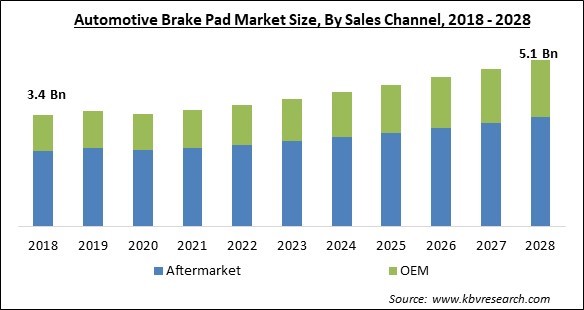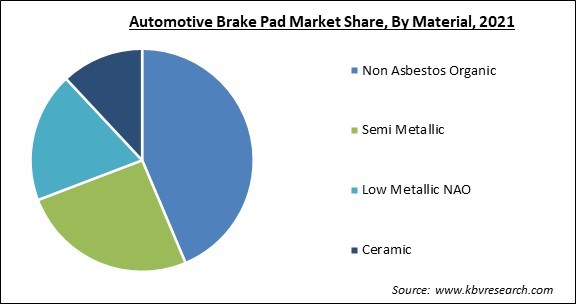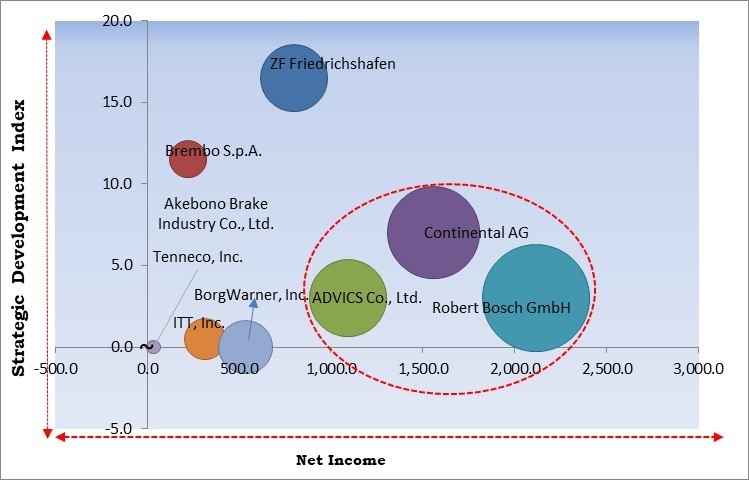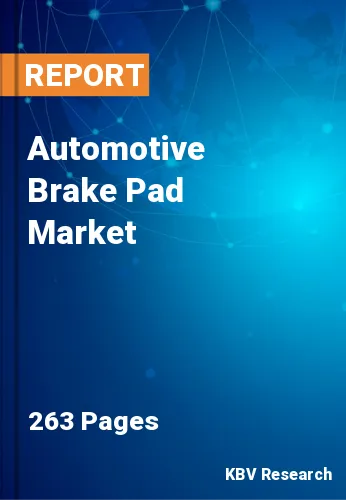The Global Automotive Brake Pad Market size is expected to reach $5.1 billion by 2028, rising at a market growth of 5.4% CAGR during the forecast period.
The brake pad is a part of a disc brake that, by moving together, can counteract the speed of the machine or vehicle. By creating friction between the brake lining and the rotor, kinetic energy is transformed into thermal energy. This is a combination of friction lining and steel backing plates. These are positioned all the way around the disc brake rotor.

By overheating, brake pads perform better in a disc brake than a drum brake. Vehicle sales have increased as a result of rising disposable income among the world's population. The selling of automobiles has increased as a result of the increase in vehicle sales worldwide. The inclusion of various technologies, such as ABS and EBD, as standard features in most new vehicles is a result of a rise in safety consciousness among vehicle consumers and government agencies.
The global market for brake pads is being driven by these innovations, which speed up brake pad wear. World trade has been spurred by expanding industrialization, which has increased the number of kilometers that commercial transport vehicles travel. The increase in kilometers traveled by transportation vehicles causes brake pads to wear out quickly, which in turn stimulates the brake pad market.
Due to their durable feature that helps to maintain a high thermal resistance while adhering to environmental norms, ceramic brake pads are heavily used in hybrid and electric automobiles. In terms of revenue generation for the worldwide electric vehicle market over the predicted period, ceramic material type is expected to lead. Compared to organic brake pads, ceramic brake pads need to be replaced less frequently and generate less dust. It ages more slowly because of the way it is built. Most automotive brake manufacturers favor it even though it has a higher manufacturing cost because of its noise-reducing qualities.
Due to the pandemic, car manufacturing was slowed down globally, but automobile makers concentrated on creating new products and declared strategic industry expansion. The volatility in automotive brake pad sales across the globe was caused by these reasons. The gradual relaxation of harsh limitations measures is predicted to boost market growth for automobile brake pads and support a recovery in consumer demand. However, with the resumption of operations and the emergence of the requirement for passenger and commercial cars, the demand for automotive brake pads had recovered its presence by the beginning of 2021.
Vehicle safety depends in part on the braking system. In order for the braking system to function properly, it is crucial to take into account both the brake pads' quality and longevity. The production of brake pads has frequently included the mixing of harmful asbestos as a raw material. Other organic substitutes for making brake pads, like coconut fiber, bamboo fiber, wood or wheat flour, and shell powder, have seen a surge in demand. Since natural fibers have numerous advantages over synthetic fibers, including low density, abundance, cheap cost, biodegradable, recyclable, renewable, and relatively high strength & stiffness, they are utilized to make eco-friendly brake pads. As a result, during the projection period, the market for automobile brake pads would experience significant expansion.
The brake pad's built-in sensors actively and in real-time pressure distribution, measure temperature, residual torque, torque, vibration, noise, and wear. The entire vehicle is made safer, more effective, greener, and connected due to proprietary sensors and algorithms employed in the brake pad system. The limitations of current micro-sensors and electronic technology in brake pads are still being researched. Smart brake pads can survive the extreme temperatures, pressures, and conditions to which brake pads are normally subjected. Therefore, it is anticipated that the development of brake pads with embedded sensors to deliver dynamic data will propel the expansion of the automotive brake pad market.
Due to the substantial initial expenditure required to create such braking technologies, only a few major automobile firms have succeeded in creating new and novel brake pad materials. Semi-metallic brake pads may be more expensive than organic pads. As a result, there is a great need for raw materials that are stable, cheap, and have high technical performance. As a result, the growth of the automotive brake pad market is expected to be constrained during the projection period due to the high development cost of brake pads.
Based on sales channel, the automotive brake pad market is segmented into OEM and aftermarket. The aftermarket segment registered the maximum revenue share in the automotive brake pad market in 2021. The quality and compatibility of aftermarket parts may not be as high as those made by the original equipment manufacturer (OEM). The aftermarket manufactures replacement, collision, aesthetically attractive, and useful parts. Customers pick these aftermarket parts because they are offered at a bargain, despite the fact that they are only minimally dependable in terms of quality and compatibility.
On the basis of material, the automotive brake pad market is fragmented into low metallic NAO, ceramic, semi metallic, and non-asbestos organic. The non-asbestos organic segment dominated the automotive brake pad market with the maximum revenue share in 2021. Due to asbestos' severe toxicity, non-asbestos organic brake pads are in high demand. Fiberglass, rubber, Kevlar, and cellulose make up its composition. It is employed in the production of everyday automobiles because of its gentle and quiet nature. However, due to increased wear and tear, the use of non-asbestos organic brake pads is restricted in high-end vehicles.
By position, the automotive brake pad market is bifurcated into front, and front & rear. In 2021, the front segment projected a prominent revenue share in the automotive brake pad market. During the forecast period, key factors including the development of new brake pad material compounds that offer high friction and impart fade resistance to performance vehicles, rising vehicle sales along with the accessibility of lightweight as well as advanced friction materials, updated vehicle safety regulations, and an increase in automotive players are anticipated to drive market growth.
On the basis of vehicle types, the automotive brake pad market is classified into two wheelers, passenger cars, light commercial vehicles, and heavy commercial vehicles. The heavy commercial vehicles segment covered a considerable revenue share in the automotive brake pad market in 2021. Manufacturers are developing and testing brake pad materials to meet driver requirements in order to get a competitive edge in the automotive brake pad market. To meet the specialized needs of OEMs building off-road vehicles like tractors and mining vehicles, companies are expanding their output capacity in premium and heavy-duty grade brake pads. Innovations in brake pads are increasingly driven by friction material and formulations.

| Report Attribute | Details |
|---|---|
| Market size value in 2021 | USD 3.6 Billion |
| Market size forecast in 2028 | USD 5.1 Billion |
| Base Year | 2021 |
| Historical Period | 2018 to 2020 |
| Forecast Period | 2022 to 2028 |
| Revenue Growth Rate | CAGR of 5.4% from 2022 to 2028 |
| Number of Pages | 263 |
| Number of Tables | 444 |
| Report coverage | Market Trends, Revenue Estimation and Forecast, Segmentation Analysis, Regional and Country Breakdown, Competitive Landscape, Companies Strategic Developments, Company Profiling |
| Segments covered | Material, Position, Sales Channel, Vehicle Type, Region |
| Country scope | US, Canada, Mexico, Germany, UK, France, Russia, Spain, Italy, China, Japan, India, South Korea, Singapore, Malaysia, Brazil, Argentina, UAE, Saudi Arabia, South Africa, Nigeria |
| Growth Drivers |
|
| Restraints |
|
Region wise, the automotive brake pad market is analyzed across North America, Europe, Asia Pacific and LAMEA. In 2021, the Asia Pacific region led the automotive brake pad market by generating the largest revenue share. This is due to rising car sales and rising consumer disposable income in emerging nations throughout the course of the projection period. The region's growth engines, China and India, are helping to fuel an increase in product demand throughout the course of the forecast. Over the course of the forecast period, factors such as the establishment of new industry players in the area and rising passenger car production and fleet size are also anticipated to fuel market growth.
Free Valuable Insights: Global Automotive Brake Pad Market size to reach USD 5.1 Billion by 2028

The major strategies followed by the market participants are Product Launches. Based on the Analysis presented in the Cardinal matrix; ADVICS Co., Ltd., Robert Bosch GmbH, and Continental AG are the forerunners in the Automotive Brake Pad Market. Companies such as ZF Friedrichshafen AG, Brembo S.p.A., BorgWarner, Inc. are some of the key innovators in Automotive Brake Pad Market.
The market research report covers the analysis of key stake holders of the market. Key companies profiled in the report include Continental AG, Robert Bosch GmbH, ZF Friedrichshafen AG, Brembo S.p.A., BorgWarner, Inc., ITT, Inc., Tenneco, Inc. (Apollo Funds), Akebono Brake Industry Co., Ltd., ADVICS Co., Ltd. (Aisin Corporation), and Brake Parts, Inc. (First Brands Group).
By Material
By Position
By Sales Channel
By Vehicle Type
By Geography
The global Automotive Brake Pad Market size is expected to reach $5.1 billion by 2028.
Rising need for eco-friendly as well as sustainable brake pads are driving the market in coming years, however, High cost of development for brake pads restraints the growth of the market.
Continental AG, Robert Bosch GmbH, ZF Friedrichshafen AG, Brembo S.p.A., BorgWarner, Inc., ITT, Inc., Tenneco, Inc. (Apollo Funds), Akebono Brake Industry Co., Ltd., ADVICS Co., Ltd. (Aisin Corporation), and Brake Parts, Inc. (First Brands Group).
The Front & Rear segment is leading the Global Automotive Brake Pad Market by Position in 2021 thereby, achieving a market value of $3.2 billion by 2028.
The Asia Pacific market dominated the Global Automotive Brake Pad Market by Region in 2021, and would continue to be a dominant market till 2028; thereby, achieving a market value of $2 billion by 2028.
Our team of dedicated experts can provide you with attractive expansion opportunities for your business.

